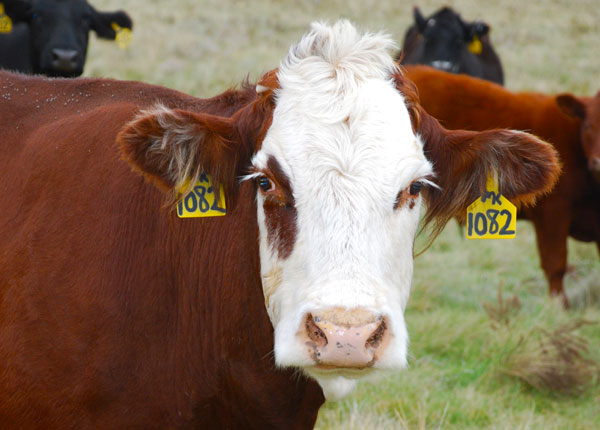Crossbreeding and the resulting heterosis have been utilized for generations. But questions still remain.
January 23, 2019

By B. Lynn Gordon
There is always a lot of discussion and debate in the cattle business about crossbreeding. Two Kansas State University researchers have teamed up to answer some of the most common questions beef producers ask about crossbreeding and address whether the questions are myths or truths.
Here are some common questions about crossbreeding.
There are benefits to crossbreeding? Truth.
“The benefits of crossbreeding are heterosis and breed complementarity,” says Bob Weaber, Extension beef cattle specialist. Historically, heterosis or hybrid vigor has been the positive outcome from crossbreeding because of the superiority of a crossbred animal as compared to the average of its straightbred parents. An increase in weaning weight, for example.
Recently, the crossbreeding discussion has included reference to breed complementarity which is the result of taking two different breeds and pairing them to complement the core traits of each breed.
“The focus is to complement each other’s strengths and weaknesses,” says Megan Rolf, K-State assistant professor of genetics. Two animals are crossed to build on the strengths of the individual animals. For example, the muscling featured in one breed to overcome the shortcoming of muscling in the other breed. Basically, it’s building off of a strength of one breed that will complement an area of needed strength in another breed to reach the end goal.
Crossbreeding results in a large increase in calf birth weight? Myth.
A large collection of data from the Meat Animal Research Center (MARC), on a variety of the major U.S. beef breeds and their crosses (over 25,000 breedings/calves in the database), re-estimated the heterosis effects on birth weight, weaning weight and yearling weight including British x British; Continental x British; and Continental x Continental, explains Weaber. “The average increase in birth weight due to heterosis was 1-1.5 pounds,” he says, “not a large increase as often believed.”
The more genetically distant the two parental breeds, the greater the amount of heterosis? Truth.
“The more divergent or different the parental breeds are, the more heterosis a beef producer will see from the mating,” says Rolf. Heterosis is derived from combinations of different alleles (commonly referred to as forms of a gene), from parent breeds, which increases heterozygosity at many places in the genome and helps individuals recover from inbreeding depression.
“For instance, crosses of British breeds like Hereford and Angus creates slightly less heterosis effect than crosses of British and Continental breeds. Crossing Bos taurus breeds with Bos indicus breeds creates substantially more heterosis than just crosses of Bos taurus breeds,” she notes.
In general, British breeds are more closely related to each other than to Continental European breeds. These breeds are diverged from each other 100-200 years ago. Recent data suggest Bos taurus cattle diverged from Bos indicus 80,000 to 100,000 years ago, making these two groups genetically distant.
Heterosis only exists in the first generation of crossbreeding? Myth.
“The mating of two straightbred animals [of different breeds] in a first cross will result in heterosis. However, the mating of an F1 and two F1 crosses (F1 cattle are the offspring from the initial cross) with the same breed composition will still result in 50% heterosis in the mating,” Rolf says.
“In fact, the mating of two crossbred animals does result in the retention of some heterosis, however, the amount of heterosis retained will be different in different crossbreeding systems depending on the system and number of breeds involved.”
A cross of unrelated lines within a breed, (for example a maternal line with a terminal line) will result in heterosis? Myth.
“Heterosis is not available from within-breed matings, rather only available by mating animals of two or more breeds,” says Weaber. For example, a Hereford x Hereford will not provide heterosis, yet, research indicates the most heterosis will occur from crossing a British animal with a Continental animal or to a Bos indicus animal.
Carcass traits benefit more from crossbreeding than reproduction traits? Myth.
Beef research demonstrates the level of heritability and heterosis are inversely related. As a result, those traits that are highly heritable tend to be the opposite when it comes to heterosis benefits.
“While carcass performance can benefit from crossbreeding, more benefit comes from focusing on breed complementarity than heterosis. Reproductive traits, which are very important to cow-calf producers, are lowly heritable, and thus get a large benefit from heterosis,” says Rolf.
Trait Heritability Heterosis
Reproduction (fertility) Low High
Production (growth) Moderate Moderate
Product (carcass) High Low
But there is more to crossbreeding than just heterosis, Rolf reminds cattlemen. This is due to the benefits that come from breed complementarity, where the focus is on the core strengths of each breed and allowing these core strengths to compliment each other across the two breeds utilized in crossbreeding. The end goal is to optimize performance levels.
“Producers can enhance the outcome of crossbreeding by taking advantage of the economically important traits like reproduction/fertility that benefit greatly from heterosis but are lowly heritable and then utilize breed complementarity and EPDs to gain a benefit from the more highly heritable traits,” concludes Weaber.
Gordon is a freelance agricultural writer and regular contributor to BEEF from Sioux Falls, S.D.
You May Also Like



